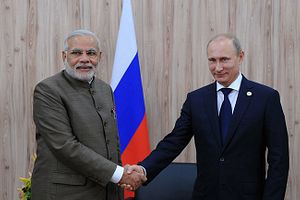India and Russia agreed in early 2007 to jointly develop a fifth generation fighter program. Ever since then, the Sukhol/HAL Fifth Generation Fighter Aircraft (FGFA) or as it is called in India, the Perspective Multi-role Fighter (PMF) project, has been plagued by delays, costs overrun, and unsteady technology In 2014, a prototype of the plane even caught fire during a demonstration flight for technical evaluation, causing heated arguments between India and Russia.
“What added to the controversy … was Russia’s refusal to share any details of this failure, to the extent that a technical evaluation team of the Indian Air Force that reportedly was present at the site was refused access to inspect the damaged platform,” Monika Chansoria, senior fellow at the Centre for Land Warfare Studies think tank in New Delhi, was quoted as saying in a Defense News article.
Yet in January of this year, Indian Defense Minister Manohar Parrikar stated that many of the differences have now been set aside: “We discussed all issues, including the FGFA, and have decided to fast-track many of them as there are apprehensions about the slow pace in their execution.” This was confirmed by his Russian counterpart, Sergei Shoigu, who emphasized his desire for more regular “interactions” to avoid further delays.
Andrey Marshankin, the regional director of international cooperation at the united Russian-Indian aircraft manufacturing company Sukhoi/HAL, set to produce the jet, further stated that, “as of now, we and our Indian colleagues have completed the creation of the export version of the [Sukhoi] PAK FA, known in India as FGFA. We already have documents and understanding of the scope of the next phase of design, the scale of future production.”
The Russian version of the plane will be a operated by one pilot, whereas the Indian Air Force prefers a two-seater plane. “In difficult conditions of modern warfare it is extremely difficult to simultaneously maneuver and attack the enemy. Currently, the Indian side suggests that the Indian version of the fifth generation fighter will be made for two pilots,” Marshankin elaborates.
Yet Jane’s Defense Weekly notes that despite of this, many problems remain: “Enduring Indian reservations over the FGFA program include those over the fighter’s AL-41F1 engine and its stealth and weapon-carrying capability. India is also insistent on Russia restoring its workload in the USD10.5 billion developmental program after recently reducing it from 25 percent to 13 percent without consulting Delhi.” India Today notes that New Delhi is paying 50 percent of the projected costs.
The Russian Air Force is set to receive the derivative version of the FGFA, the Sukhoi T-50 PAK FA, this year. According to International Business Times, Russia will field 55 T-50 jets over the next four years. According to other media reports, the PMF will include combat avionics, stealth, super-cruise, and sensors improvements over the T-50 PAK FA.
Without additional delays, the PMF will be introduced into the Indian Air Force by 2022. Russia is expected to build 250 FGFAs, while India downgraded its initial purchasing size from 200 to 144 planes in 2012 at an estimated total cost of $ 30 billion. However, this number may rise due to China’s development of the J-20 and J-31 fifth generation fighters. More than 60 percent of India’s military platforms are Russian in origin.































